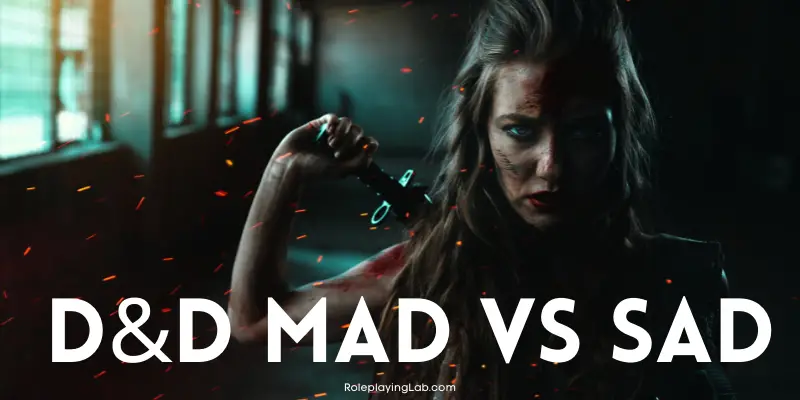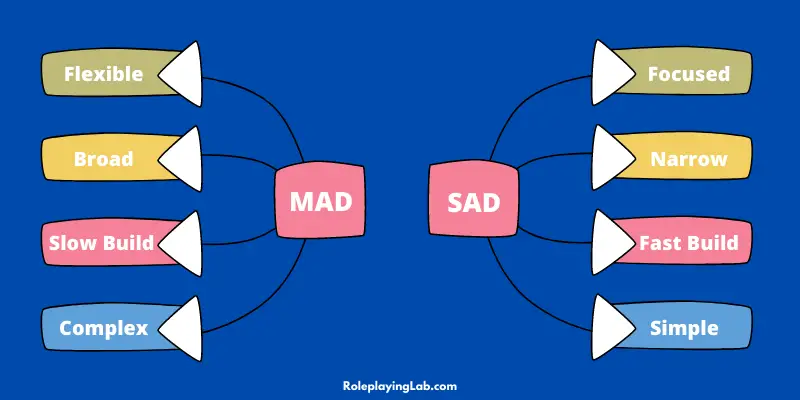In Dungeons and Dragons (DND), there are two types of characters—MAD and SAD.
Here is what you need to know about MAD vs SAD characters in DND:
MAD stands for “Multiple Ability-Score Dependent” while SAD stands for “Single Ability-Score Dependent.” The main difference between them is that MAD characters spread their stats out across several attributes while SAD characters focus most of their points on one attribute.
In this article, you’ll learn everything you need to know about MAD vs SAD characters in DND.
What Does MAD Mean in DND?

MAD stands for “Multiple Ability-Score Dependent.”
MAD classes and characters are those that rely on multiple attributes to be successful. For example, a high-level fighter might need Strength for damage, Constitution for hit points, and Dexterity for armor class.
A Monk might need high scores in multiple attributes as well:
- Strength
- Wisdom
- Dexterity
- Constitution
While MAD characters can be more difficult to play, they tend to be more versatile.
In other words, they can help out and succeed in a wider range of situations.
If you enjoy playing a class that can contribute in many different ways, a MAD class might be right for you.
What Does SAD Mean in DND?
SAD stands for “Single Ability-Score Dependent.”
SAD classes are those that rely on only one attribute to be successful. For example, a tanky barbarian might only need Strength for damage, and a classic wizard only needs Intelligence for spells.
While SAD classes can be easier to play, they tend to be less versatile and can struggle in certain situations.
If you enjoy playing a class that is simple and straightforward, a SAD class might be right for you.
What Are the Major Differences Between MAD and SAD Characters in D&D?

There are several differences between MAD and SAD characters in D&D.
When comparing MAD vs SAD characters in DND, it’s helpful to explore these differences.
MAD Characters
- Rely on multiple attributes, making them highly adaptable: A MAD character can usually find a way to contribute in any given situation. They are your “all-around” strong characters.
- Can be more difficult to play: Managing multiple attributes can be challenging, and you’ll need to be careful not to spread yourself too thin. It can take longer to build your character.
- Usually have more options available: With multiple attributes to work with, MAD characters often have more options in gameplay. They can hit hard, run fast, and may be able to cast a spell in a bind. If one attribute fails, they can rely on another.
SAD Characters
- Rely on only one attribute, making them less flexible: A SAD character might struggle in situations where their primary attribute is not useful.
- Can be easier to play: Focusing on only one attribute can make your character simpler to play. Your character often advances in their single attribute more quickly. For example, a punch wizard becomes more punchy.
- Usually possess fewer options: With only one attribute to work with, SAD characters often have fewer options available to them. An intelligence-focused wizard can really only cast spells.
- Can struggle in certain situations: If a SAD character’s primary attribute is not useful in a given situation, they might be at a disadvantage.
Is a MAD or SAD Character Better?
Neither is inherently better than the other. It really depends on your personal preference.
However, a MAD or SAD character might be better for you based on how you want to build your character.
Consider these factors:
- How many optimizations do you want to do?
- What kind of role do you want to play in the party?
- What kind of campaign are you playing?
- How much experience do you have with DND?
How Many Optimizations Do You Want to Do?
When you have a MAD character, you need to optimize all of your stats equally in order to be effective.
This can be challenging and time-consuming. If you want to min/max your character, then a MAD character might be a good fit for you.
If you don’t mind making many optimizations, then MAD might be for you.
What Kind of Role Do You Want to Play in the Party?
If you want to be the “jack of all trades,” then a MAD character might be a good fit.
Most people tend to think of “jack of all trades” as a negative phrase, implying that the person in question is a “master of none.”
However, there are plenty of advantages to being a jack of all trades.
For one thing, MAD characters are generally more well-rounded than specialists.
They’re able to take on a variety of tasks and usually have a better understanding of how different disciplines interact with one another.
This makes them ideal candidates for positions that require creative problem-solving or cross-functional collaboration. Additionally, MADs tend to be more adaptable than specialists and thus better able to deal with change.
On the other hand, if you want to specialize in one particular area, then a SAD character might be a better option.
What Kind of Campaign Are You Playing?
In a high-powered campaign, having a MAD character might be more necessary in order to keep up with the rest of the party.
However, in a more casual campaign, a SAD character might be just fine.
On the same note, in an expansive campaign that juggles different kinds of encounters, a MAD character might come in handy.
For example, a campaign that switches between puzzles and close-quarters combat.
If your campaign is located mostly in the same location with similar encounters, then SAD will work.
How Much Experience Do You Have with DND?
If you’re new to D&D, then a SAD character might be easier to play.
MAD characters can be more challenging and require more experience with the game.
Ultimately, the decision of whether to play a MAD or SAD character is up to you. Consider your own preferences and the factors listed above when making your decision.
If you’re still undecided, why not try out both and see which one you like best?
There’s no harm in experimenting, and you might just find your new favorite character class in the process.
SAD Classes in DND
There are a number of SAD classes in D&D, each with its own unique strengths and weaknesses.
Here are some of the most popular:
- Barbarian: A barbarian really only needs Strength for damage, making them a simple yet effective class. However, they can struggle in situations where their damage is not useful.
- Wizard: Intelligence is used to determine how many spells a wizard can cast per day, as well as how difficult those spells are to resist. As a result, wizards who have high intelligence scores are able to cast more and stronger spells than those with lower scores.
- Rouge: This is the thief-class of D&D. Quick and nimbleness rely mostly on dexterity.
MAD Classes in DND
There are also several MAD classes in D&D.
Each MAD character class comes with its own advantages and disadvantages.
Here is a list of some of the most popular:
- Fighter: A fighter needs Strength for damage and Constitution for hit points, making them a slightly more complicated class to play. They might also have high dexterity to buff their armor class.
- Paladin: The paladin is a holy warrior, able to use their faith to smite evil and heal their allies. They need Strength for damage and Charisma for their spells, making them a bit of a challenge to build and play.
- Ranger: The ranger is a skilled hunter, able to track and find their prey with ease. They need Dexterity for accuracy and Wisdom for their spells, making them a difficult class to play.
- Bard: The bard is a jack-of-all-trades class, able to sing, dance, and play instruments to buff their allies or debuff their enemies. They are also proficient in simple weapons and light armor.
DND MAD Builds
While any class can be played as MAD, some classes are better suited to it than others.
Here are a few popular MAD builds in D&D.
Fighter/Paladin: This build is all about melee damage, with the fighter providing the brute force and the paladin adding precision and holy power. For this build, you’ll want high scores in strength and charisma.
Ranger/Druid: This build is perfect for those who want to play a nature-themed character. The ranger provides the skills and accuracy, while the druid brings the magic and shapeshifting. Shoot for high scores in dexterity and wisdom.
Tank Sorcerer/Wizard: This build is for those who want to play a powerful combat spellcaster. The tank barbarian class provides the raw power, while the wizard/sorcerer brings a wide array of spells to the table. Go heavy on strength and intelligence.
DND SAD Builds
While any class can be played as SAD, some classes are better suited to it than others.
Here are a few of the best SAD builds in D&D.
Barbarian/Fighter: This build is all about raw damage output, with the barbarian providing the brute force and the fighter adding precision. In this build, shoot for high strength scores.
Wizard: This build is perfect for those who want to play a supporting spellcaster. Simply jack up your intelligence as high as possible.
Rogue/Assassin: This build is for those who want to play a character that specializes in stealth and subterfuge. The rogue provides the skills and sneak attacks, while the assassin adds poison and precision. Aim for high dexterity.
Are Paladins MAD?
The paladin is a MAD class.
In the world of D&D, a paladin is a holy warrior who is sworn to protect the innocent and vanquish evil from the world.
As such, paladins are incredibly versatile characters.
They are capable of both dealing massive amounts of damage in combat and using powerful magic to heal their allies and smite their enemies.
However, this versatility comes at a cost.
Paladins must carefully manage their two key ability scores: Strength and Charisma.
Strength is crucial for paladins, as it determines the amount of damage they can deal with their weapons. Without a decent Strength score, a paladin will quickly find themselves outclassed by other melee combatants such as Barbarians and Fighters.
Likewise, Charisma is essential for paladins who want to make use of their spellcasting abilities.
The higher a paladin’s Charisma score, the more powerful their spellcasting ability.
Paladins must carefully balance these two ability scores in order to be effective at both combat and spellcasting.
This makes them a Multi-Ability Score-Dependent (MAD) class, as they need high scores in both Strength and Charisma to be truly effective.
While this may seem like a daunting task, many players enjoy the challenge.
And if you build them right, paladins can be a powerful force on the battlefield.
Conclusion: MAD vs SAD Characters in DND
MAD and SAD are two different ways to build a character in D&D.
Each build comes with pros and cons, so it’s important to select the right build for your playstyle.
Related articles:
- What Is a D&D Character? (Best Guide for Beginners)
- Highest AC in DND: Complete Stats, Builds, and Calculations
- Can Your DND Character Be Anything? (Solved)
- Can You Play as a Dragon in D&D? (Answered & Solved)
- Can You Become a God in D&D? (Answered)
